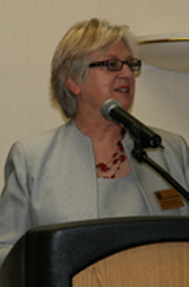California Gov. Jerry Brown's proposal to reduce state funding to the University of California by $500 million or 16.4 percent means UC Santa Cruz will need to cut its operating budget by $31 million for fiscal year 2011-2012 beginning July 1.
UC President Mark Yudof allocated budget-cut targets to each of the system's 10 campuses; at $31 million, UCSC's share is 6 percent.
If the 2011-12 state budget is approved as proposed, students will for the first time pay more in tuition and fees than the state provides in per-student funding. In 20 years, state support for per-student educational costs has fallen 57 percent, adjusted for inflation.
"It's almost unthinkable to imagine what will happen," Chancellor George Blumenthal told state legislators Feb. 4 at a UCSC legislative forum in Santa Cruz.
"That's the entire budget of our physical and biological sciences division, or our school of engineering and our arts division combined," commented Campus Provost/Executive Vice Chancellor Alison Galloway at the same forum.
Some cuts, however, have already been absorbed, making the process no less painful but not as draconian as it might have been. Anticipating future cuts last year, UCSC administrators reduced the permanent budget instead of relying on temporary funds to tide them over to a brighter day.
"Because of that prudent action," Galloway explained in a February 7 message to the campus community, "we now face an additional shortfall of approximately $19 million."
Galloway has asked campus leaders for proposals on how to reach that figure based on the priorities of providing for the academic needs of students, teaching and research resources for faculty, and the campus's need to seek additional revenue from non-state sources.
Academic divisions were assigned 6 percent cut targets. Those range from $635,000 in the arts division to $1.7 million for physical and biological sciences.
All other units including the library, business and administrative services, and informational technology services face 16 percent cuts. The library alone faces a $1.5 million cut which will bring cumulative cuts over four years to 34 percent.
Academic divisions are meeting with faculty and staff to figure out how to hit the targets.
In coming weeks, Blumenthal and Galloway plan to hold two town hall meetings to hear from students, faculty, and staff about the budget crisis.
The situation could get worse. The proposed $500 million cut in state aid is based on an assumption that state voters will vote in June to extend a temporary increase in income, vehicle, and sales taxes. If the measure fails to make the ballot, or if voters fail to approve the extensions, the cut to the university and hence the campuses could be much greater.
In addition, all campuses face unfunded cost increases over the next fiscal year on such things as health benefits, utilities, negotiated pay increases, and retirement fund contributions that could increase the amount that must be cut.
UCSC makes plans to deal with expected cut in state funding



